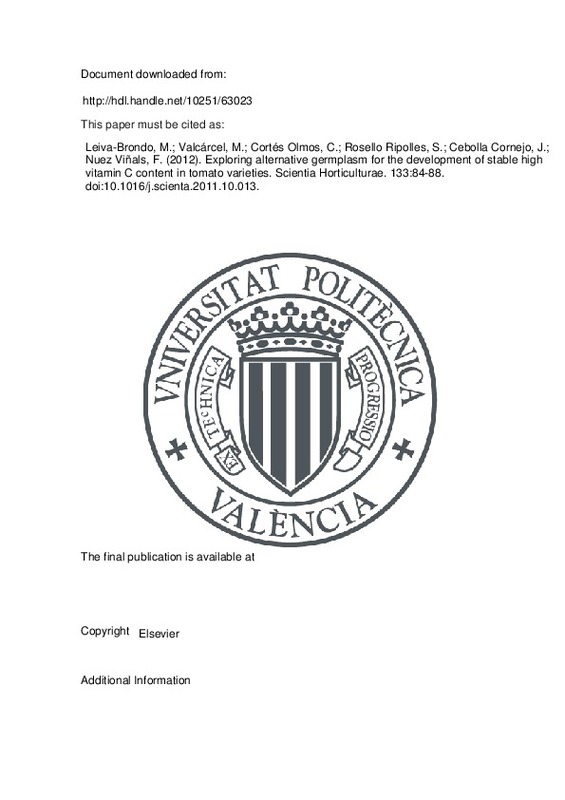JavaScript is disabled for your browser. Some features of this site may not work without it.
Buscar en RiuNet
Listar
Mi cuenta
Estadísticas
Ayuda RiuNet
Admin. UPV
Exploring alternative germplasm for the development of stable high vitamin C content in tomato varieties
Mostrar el registro sencillo del ítem
Ficheros en el ítem
| dc.contributor.author | Leiva-Brondo, Miguel
|
es_ES |
| dc.contributor.author | Valcárcel, M.
|
es_ES |
| dc.contributor.author | Cortés Olmos, Carles
|
es_ES |
| dc.contributor.author | Rosello Ripolles, Salvador
|
es_ES |
| dc.contributor.author | Cebolla Cornejo, Jaime
|
es_ES |
| dc.contributor.author | Nuez Viñals, Fernando
|
|
| dc.date.accessioned | 2016-04-27T07:08:45Z | |
| dc.date.available | 2016-04-27T07:08:45Z | |
| dc.date.issued | 2012 | es_ES |
| dc.identifier.issn | 0304-4238 | |
| dc.identifier.uri | http://hdl.handle.net/10251/63023 | |
| dc.description.abstract | The genotypic potential for high l-ascorbic acid content of 15 accessions of S. lycopersicon and S. pimpinellifolium has been evaluated in three environments, including open-air and glasshouse cultivation and two localities. The environmental effect on l-ascorbic acid accumulation was highly genotype-dependant and the variance ascribed to the G×E environment was similar in importance to that ascribed to genotype. The variation found within accession might be ascribed to microenvironmental effects associated with temperature changes and oxidative stress or population variability. Several accessions with high genotypic values (¿+G) have been identified. Among them, accession PI365959 of S. pimpinellifolium, showed a genotypic value of 293.8mgkg -1, statistically significant higher (P<0.05) than the genotypic potential of controls reported to have high l-ascorbic content (CDP4777, 115.0mgkg -1). It also showed positive G×E interactions, with a relatively high stability. Accession LA1423 of S. lycopersicon var. cerasiforme, despite being less stable, had also high genotypic values for l-ascorbic acid accumulation (197.4mgkg -1). This germplasm will be of great interest for the development of new tomato cultivars targeted to added-value markets appreciating nutritional or functional quality. The close relationship of the selected material with the cultivated tomato will enable an efficient and rapid exploitation of their potential in breeding programmes. © 2011 Elsevier B.V. | es_ES |
| dc.language | Español | es_ES |
| dc.publisher | Elsevier | es_ES |
| dc.relation.ispartof | Scientia Horticulturae | es_ES |
| dc.rights | Reserva de todos los derechos | es_ES |
| dc.subject | Ascorbic acid | es_ES |
| dc.subject | Functional quality | es_ES |
| dc.subject | Germplasm | es_ES |
| dc.subject | Tomato breeding | es_ES |
| dc.subject | Breeding | es_ES |
| dc.subject | Cultivar | es_ES |
| dc.subject | Cultivation | es_ES |
| dc.subject | Fruit | es_ES |
| dc.subject | Genotype | es_ES |
| dc.subject | Nutritional status | es_ES |
| dc.subject | Lycopersicon | es_ES |
| dc.subject | Lycopersicon esculentum | es_ES |
| dc.subject.classification | GENETICA | es_ES |
| dc.title | Exploring alternative germplasm for the development of stable high vitamin C content in tomato varieties | es_ES |
| dc.type | Artículo | es_ES |
| dc.identifier.doi | 10.1016/j.scienta.2011.10.013 | |
| dc.rights.accessRights | Abierto | es_ES |
| dc.contributor.affiliation | Universitat Politècnica de València. Departamento de Biotecnología - Departament de Biotecnologia | es_ES |
| dc.contributor.affiliation | Universitat Politècnica de València. Instituto Universitario de Conservación y Mejora de la Agrodiversidad Valenciana - Institut Universitari de Conservació i Millora de l'Agrodiversitat Valenciana | es_ES |
| dc.description.bibliographicCitation | Leiva-Brondo, M.; Valcárcel, M.; Cortés Olmos, C.; Rosello Ripolles, S.; Cebolla Cornejo, J.; Nuez Viñals, F. (2012). Exploring alternative germplasm for the development of stable high vitamin C content in tomato varieties. Scientia Horticulturae. 133:84-88. doi:10.1016/j.scienta.2011.10.013 | es_ES |
| dc.description.accrualMethod | S | es_ES |
| dc.description.upvformatpinicio | 84 | es_ES |
| dc.description.upvformatpfin | 88 | es_ES |
| dc.type.version | info:eu-repo/semantics/publishedVersion | es_ES |
| dc.description.volume | 133 | es_ES |
| dc.relation.senia | 206096 | es_ES |







![[Cerrado]](/themes/UPV/images/candado.png)

